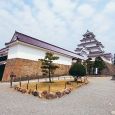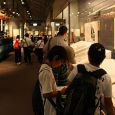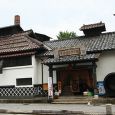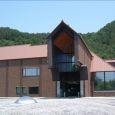Fukushima
Advertisement
By plane
It is a 40-minute bus ride from Fukushima Airport to Koriyama station , from which you will then have to travel to Fukushima station by Shinkansen or local train . It may be a bit more convenient to arrive in Tokyo and take the Shinkansen from there.
By train
Fukushima is a stop on the Tohoku Shinkansen line between Tokyo and Sendai, and is also served by the JR Tohoku and Yamagata lines. The Yamagata Shinkansen branches off here, traveling over conventional lines to Yamagata and Shinjo.
The travel time from Tokyo to Fukushima by Shinkansen is approximately 1 hour 45 minutes, with 2 to 4 departures every hour at a cost of ¥8500 each way .
By bus
JR Bus' Abukuma makes five daily round-trips to Fukushima from Shinjuku Station in Tokyo . At night, JR Bus runs the Dream Fukushima from Tokyo and Yokohama stations. Tohoku Bus' overnight bus, called the Suite, is cheaper at ¥4500 but arrives earlier in the morning.
Kintetsu Bus and Fukushima Kotsu's Galaxy bus runs overnight to Fukushima from Kyoto and Osaka .
Tsuruga Castle
Tsuruga Castle was built in 1384 and changed hands many times between the different rulers of the Aizu region. It was destroyed after the Boshin War of 1868, a rebellion against the newly formed Meiji government, which had taken over control from the Tokugawa shogun and put an end to Japan's feudal era. Tsuruga Castle was one of the last strongholds of samurai loyal to the shogunate.
The castle was rebuilt as a concrete reconstruction in the 1960s. In renovation works completed in 2011, the color of the roof tiles was reverted from grey to the original red, a unique color among Japanese castles. Visitors can enter and climb to the top floor of the castle keep and look out onto the surrounding city. The inside of the building is an interesting museum with attractive displays about the history of the castle and the samurai lifestyle.
Fukushima Prefectural Museum
Fukushima Prefectural Museum has an extensive permanent exhibition that illustrates Japan's entire history, stretching from archaeological finds from the Jomon Period (300 BC) to artifacts of daily life in the 1950s. The building is big and spacious, allowing the museum to feature quite large and impressive displays.
In addition to the permanent exhibition, there is space devoted to hosting varying temporary exhibitions that pass through. The Fukushima Museum presents an interesting and informative survey of Japanese history and culture, as well as the particularities of Fukushima Prefecture. A thorough English pamphlet is available which explains most of the permanent exhibition.
Aizu Sake Museum
Aizu is naturally blessed with the three requisites for brewing good sake: high quality rice, an abundance of pure water, and cold weather. Rice and water are the two ingredients of sake, and the cold weather is desirable during the fermentation process. Since Aizu's sake brewers could avail themselves to these things before the advent of modern technology, the region has had a long tradition of sake brewing.
Over the course of Aizu's rich sake producing history, local technique and expertise has developed immensely and many quality sake producers have evolved. One of them, Miyaizumi, has partly converted its old brewery into the Aizu Sake Museum.
The museum offers visitors a look at both Aizu's sake brewing history and the sake making process generally. Both modern and traditional sake making equipment is on display. Adding to the enjoyment of a visit, some sake sampling opportunities are available. There is also a gift shop that sells sake related goods.
Oyakuen Garden
Oyakuen is a pleasant Japanese landscape garden where visitors to Aizu can go for a quiet stroll. Oyakuen can be translated as "Medicinal Herb Garden", a name given in the 18th century when the feudal lord encouraged citizens to cultivate medicinal plants at the site. So, in addition to its principal landscape garden, Oyakuen has a herb garden where hundreds of types of medicinal plants are still grown.
Oyakuen's main garden consists of carefully cultivated greenery centered around a pond. A path winds around the the pond, and walking along it is the best way to enjoy the garden. There are a few buildings at Oyakuen which may be of interest to travelers a tea house, a souvenir shop and a dining room.
Hanami-Yama Park
Hanami-Yama park (or park or flower viewing), the Fukushima Prefecture Fukushima in the flower garden of the farm names of private land. Southeast of the city,the right bank of the hills in the middle Watari in the district. Owners park has been open to the public free of charge, as especially in the spring cherry blossom season, which attracted many tourists.
Farmers have been around the park flower gardening, flowers blooming in the area for the district,has also been used as a generic term for the entire district.
Hanamiyama Park
This park is the place to go in spring for cherry blossom viewing. It is quickly becoming a place famous throughout Japan, be prepared for crowds. You can take a short trail up a hill and see some amazing panoramas as well as enjoy walking underneath gorgeous light-pink canopies. There are regular buses leaving for Hanamiyama from the train station. Ask the people at the tourist office for more details.
Five Colored Lakes
These lakes are a beautiful attraction visited by many sightseers. The lakes were formed after Mount Bandai erupted in the 1800's. The minerals from the eruption give each lake a different color.
March - July






